How fast can crocodiles swim?
Crocodiles are archosaurs, an ancient group of reptiles that also included dinosaurs. These semi-aquatic animals inhabit rivers, estuaries, lakes, and swamps. They have armored skin for protection and perfectly placed eyes and nostrils on top of their heads. This positioning allows these reptiles to submerge their body fully underwater while still keeping tabs on what’s happening above the surface. Then when it’s time to strike, they can zip through the water, closing in on whatever poor animal they’ve set their sights on.
Exactly how fast can crocodiles swim? Read on to find out!
How Fast Can Crocodiles Swim?
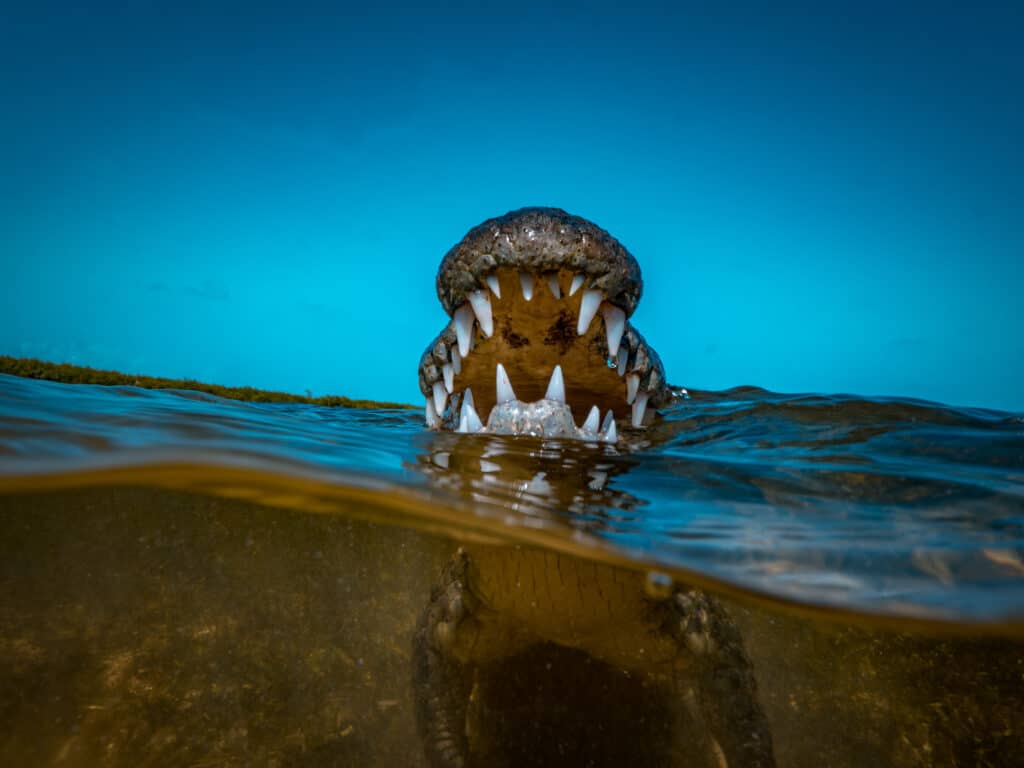
Crocodiles use their flattened tail and web feet to swim 15 to 18 mph.
©Willyam Bradberry/Shutterstock.com
Crocodiles can swim 15 to 18 mph. That means they can easily outswim the best Olympic swimmer. They thrash their flattened tail back and forth to propel through the water. And their webbed feet help them move upward and downward.
Where can you find crocodiles swimming around? Lots of places. These reptiles have a wide range. There are even some crocodiles swimming around in southern Florida.
American crocodiles live in coastal areas throughout the Caribbean. They can lie in brackish or saltwater areas like ponds, coves, and creeks in mangrove swamps. However, they are sometimes found inland in freshwater areas of the Southeast Florida coast.
Crocodiles Are Ectothermic Creatures
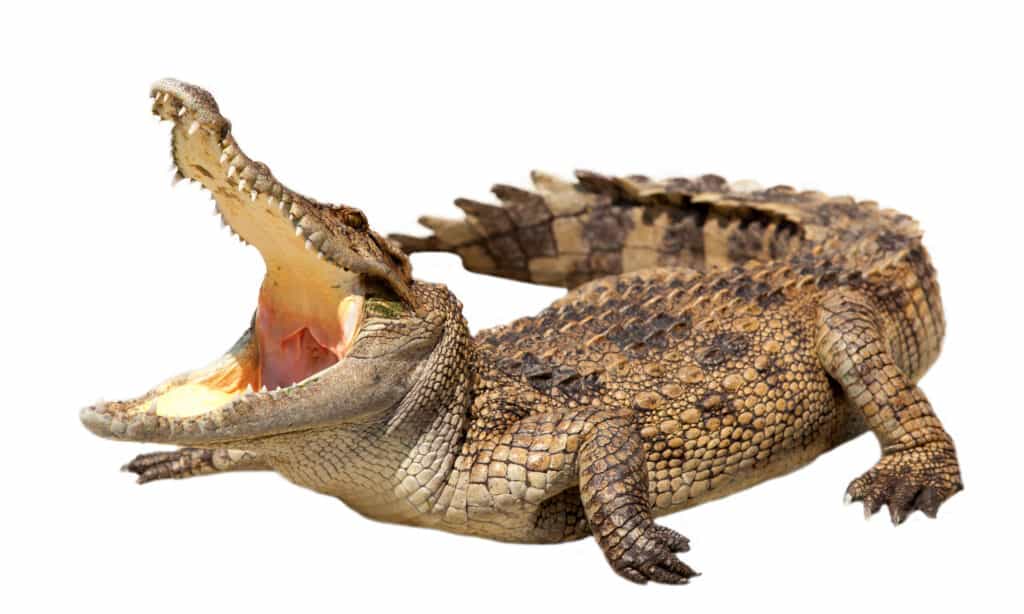
While basking in the sun, crocodiles will open up their mouths to warm up even faster.
©iStock.com/nattanan726
Crocodiles, like alligators, are ectothermic. They can’t control their body temperature like most mammals can. Instead, they rely on outside sources to warm up or cool down. That’s why you’ll see these armored beasts basking in the sun or moving to areas with warmer or cooler temperatures. If you’ve ever seen a picture of a basking crocodile, you may have noticed that its mouth is open. This is gaping, a technique that helps them soak in more sun rays to help keep their bodies nice and toasty.
A hungry crocodile has all sorts of animals it can choose to eat. Sometimes they dine on small mammals and birds, while other days, they focus on eating frogs, turtles, or fish.
When they’re not hunting or basking in the sun, crocodiles like to cool off. They do this by laying in the shade of trees or by getting in the water. That is, unless it’s mating season. Things get a bit more active when courting rituals begin. Expect head slaps, snout rubbing, and submerging under water to show off. Nesting occurs in late April and early May.
Crocodile Have Narrow Snouts

Compared to alligators, crocodiles have a more narrow snout.
©Firepac/Shutterstock.com
We’ve all heard the famous rhyme, “See you later, alligator!” It’s sometimes followed by, “After a while, crocodile.” But how do you know who you’re seeing later or catching up with after a while? Is it a gator or a croc? The trick to telling alligators apart from crocodiles is easier than you might think. Just look at their snout.
Crocodiles have a narrow tapered snout, while alligators have a broad rounded snout. Another giveaway is their smile. Crocodiles show their fourth tooth on their lower jaw when their mouth is closed. While alligators show their upper teeth when their mouth is closed.
Crocodiles Are Team Players

Crocodiles can work together to kill prey during coordinated game drives.
©Robert Styppa/Shutterstock.com
Recent studies have shown that crocodiles and their relatives are intelligent animals who understand the value of teamwork. Sometimes, crocodiles hunt as a team, as discovered by Vladimir Dinets.
Crocodiles and alligators organize game drives. They do this by swimming in circles to corral and capture fish. Witnessing a prey drive is amazing in and of itself, but what’s even more amazing is what’s happening behind the scenes.
Different-sized crocodiles take on specific roles during the game drive. That means the roles are based on size and skill. They can anticipate each other’s positions and actions. By working together, they can catch more prey than they might be able to on their own.
Crocodile Eyes Are the Same Size As Yours
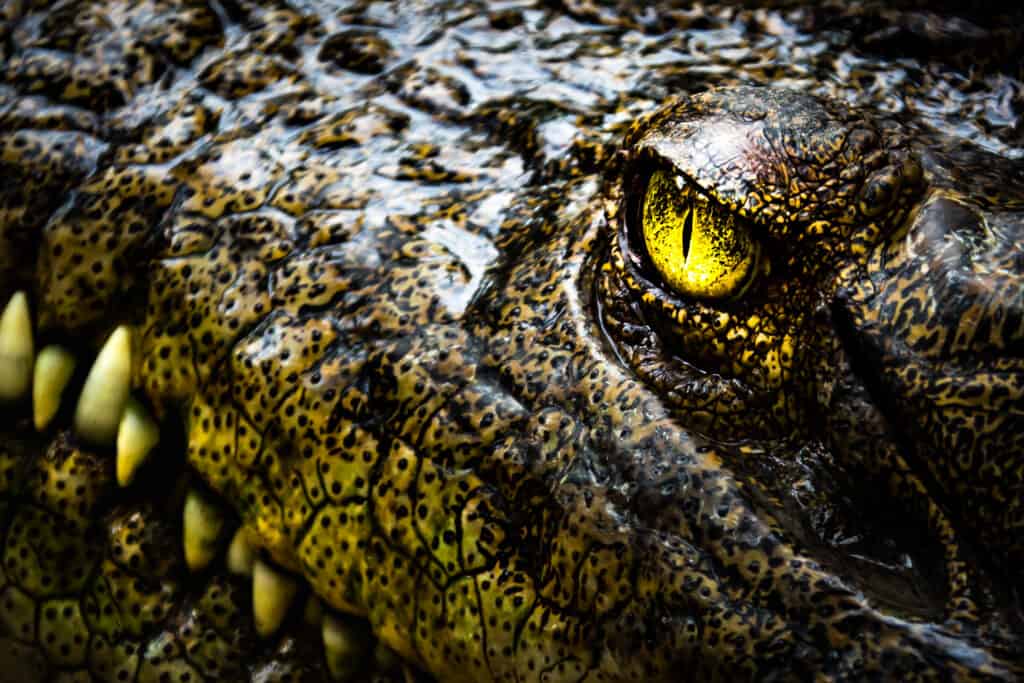
Crocodile eyes are the same size as humans.
©Torychemistry/Shutterstock.com
You have something in common with crocodiles; your eyes! Well, the size of your eyes. Crocodile eyes are about the same size as human eyes and can be brown or green in color. And they’re capable of recognizing colors both on land and underwater.
Crocodiles also have good peripheral vision due to the unique placement of their eyes on their head. Crocodile eyes are on the top of their head, allowing them to wait and ambush prey while hiding below the water’s surface. And they can retract their eyeballs into the sockets for protection during fights. To top it off, they even have a heavy fold of armored skin above each eye.
3 Eyelids
In total, crocodiles have three eyelids, with the top and bottom ones protecting and hydrating their eyes and the third transparent one offering underwater protection. That’s right, they have a transparent third eyelid that acts like built-in goggles, enabling them to see shapes underwater.
Night Vision
Look at a crocodile’s eye, and you’ll notice there’s a vertical slit for a pupil that can close to a narrow line. Their pupils can fully open at night to enhance their vision. In a way, it’s like they have their very own built-in night vision although it’s not as clear as in daylight. Crocodiles can see underwater thanks to the same mirrored receptors that help them see at night.
They Love to Surf
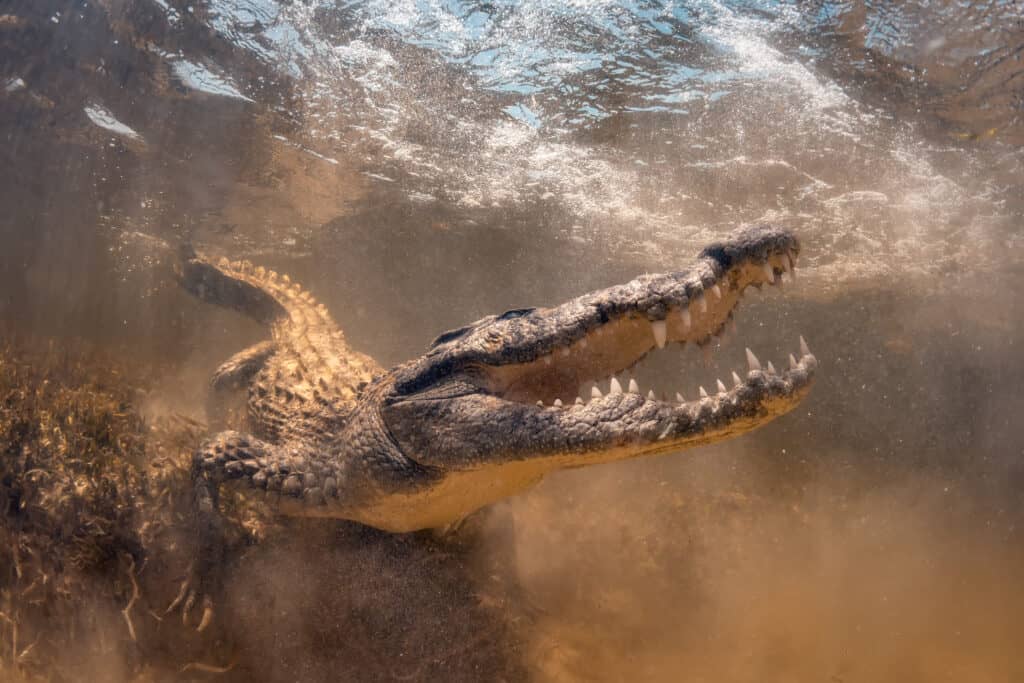
Crocodiles cover long distances by riding favorable ocean currents.
©Alexander Machulskiy/Shutterstock.com
Crocodiles can swim fast, but they’re not the most skilled swimmers out there. To make up for their lack of skill, they choose to surf!
Australian researchers have found that saltwater crocodiles can travel long distances by “surfing” on ocean currents. They can survive for long periods in saltwater without eating or drinking. And they cover these long distances by sea by riding favorable surface currents. In other words, crocodiles know how to surf for survival.
The research involved capturing and tagging 20 crocodiles, a task that couldn’t have been easy to complete. They were able to track the crocodiles using sonar sensors and satellite transmitters. They discovered crocodiles would start their long journeys within an hour of the tide changing. Allowing them to take advantage of favorable conditions.
One crocodile traveled 366 miles in 25 days. Their journey took them from a river mouth to the west coast of the Cape York Peninsula, Australia. They made the journey by surfing a seasonal current within the Gulf of Carpentaria.
Their Skin Is Super Sensitive
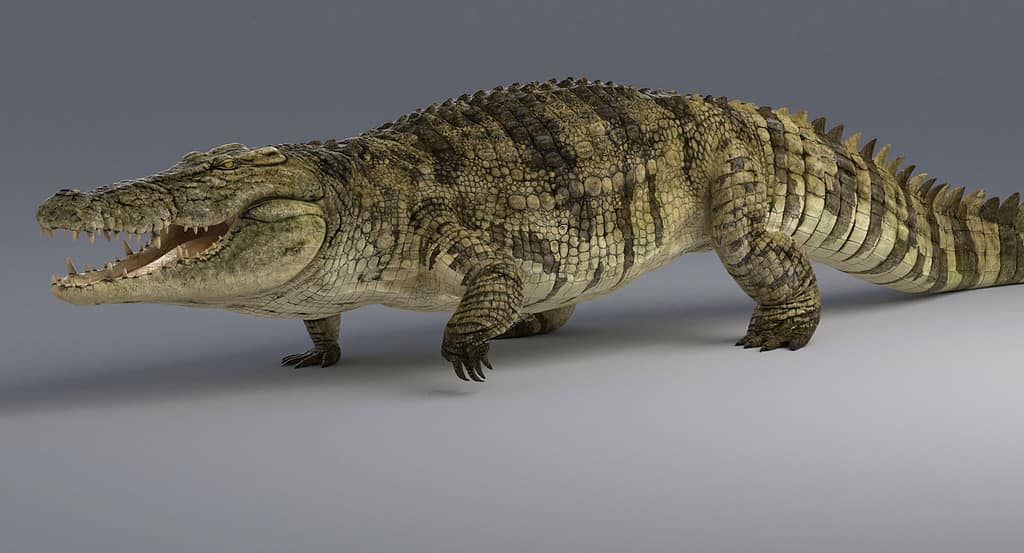
Crocodile skin has integumentary sensor organs that let them detect ripples in the water.
©1 2 3D illustration/Shutterstock.com
Crocodile skin is super touchy!
Even though crocodiles have thick armored skin, they can still pick up on slight sensations. This ability helps them detect water movements created by swimming prey. The tiniest movement can help a crocodile determine the location of prey.
How does a crocodile feel things? Their sense of touch is concentrated in small, pigmented domes called integumentary sensor organs (ISOs). The ISOs are present all over their bodies, and they contain touch sensors that are more sensitive to pressure and vibration than human fingertips.
Some touch sensors detect tiny water ripples, while others respond to pressure. For instance, the ISOs in the mouth near the teeth are heavily wired, helping the crocodiles know when there’s something caught in their jaws.
The touch sensors also enable female crocodiles to delicately break open their eggs when they are ready to hatch. And since they can feel when something in their jaws, it’s easy to carry their young around without harming them. Although, mothers are known to occasionally eat their babies on purpose. And to carry their hatchlings in their jaws.
Crocodiles Have Been Around 200 Million Years
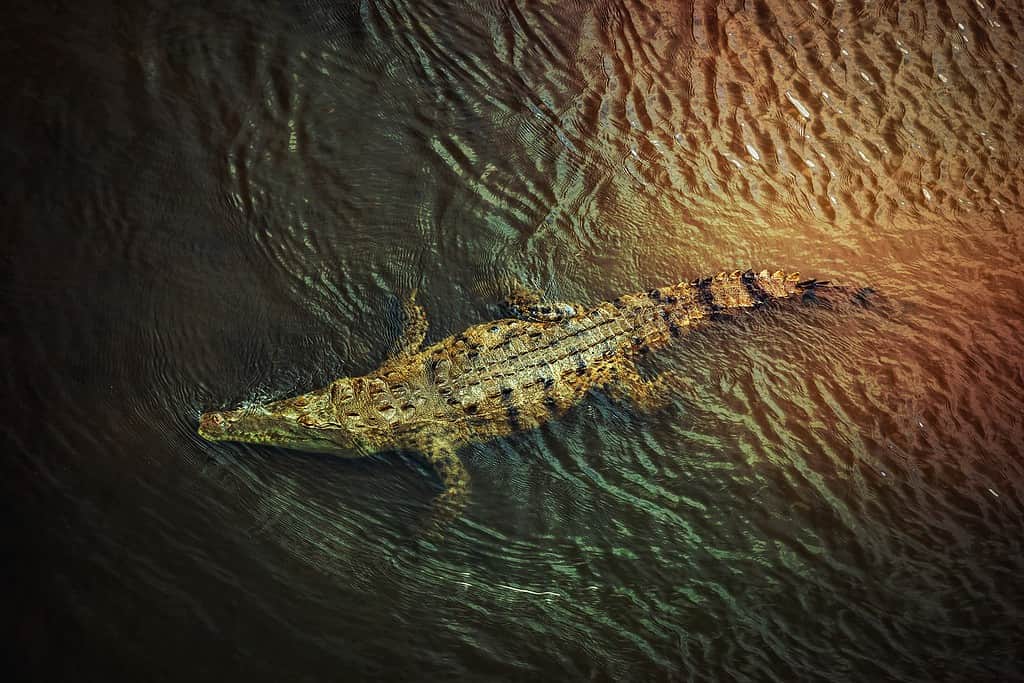
Crocodiles are one of the oldest living creatures around.
©delrigorita/Shutterstock.com
Crocodilians have been around for about 230 million years and have survived various environmental changes. They are one of the oldest reptile groups, with only turtles, tortoises, and tuatara being older.
You can divide crocodilians into different families. For instance, crocodiles belong to the family Crocodylidae. In comparison, alligators belong to the family Alligatoridae. Finally, caimans are a type of alligator, and gharials belong to the family Gavialidae. The United States is home to the American alligator and a small population of American crocodiles.
Crocodiles Are a Flagship Species
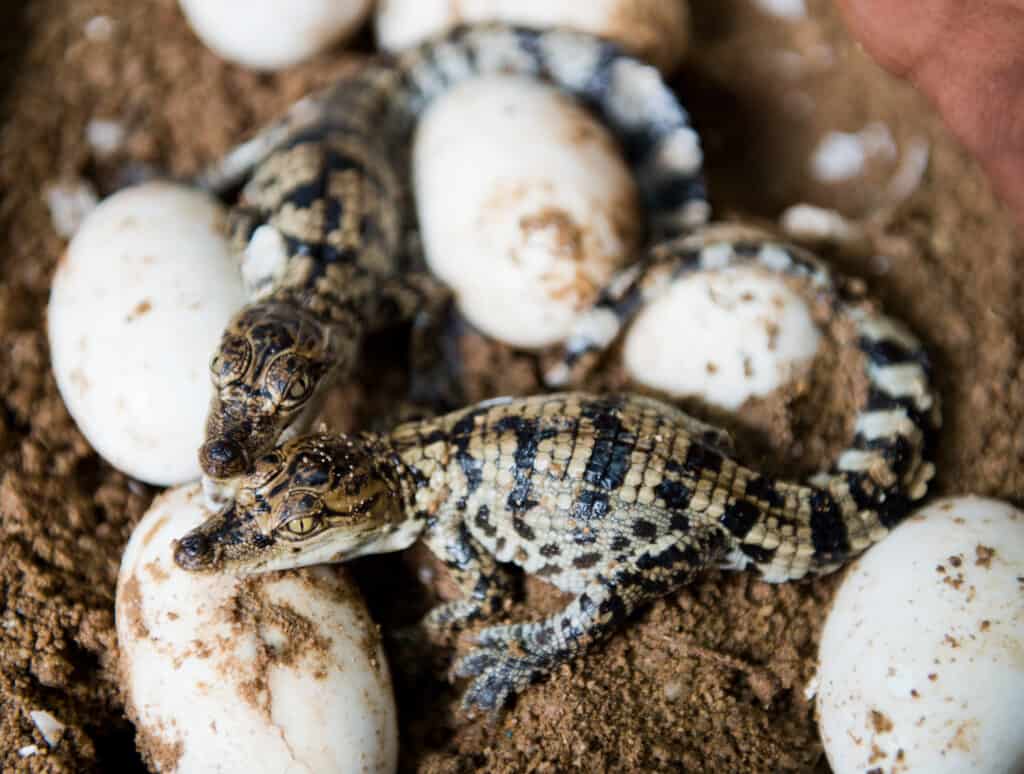
Scientists monitor crocodile nesting sites to determine the health of the ecosystem.
©hxdbzxy/Shutterstock.com
The American crocodile helps us monitor the environment, making them a “flagship” species. They help conservationists and scientists monitor habitats. In the case of crocodiles, they’re particularly helpful in monitoring the freshwater flow into estuaries.
Crocodile survival rates link to factors like rainfall, water level, and salinity. These reptiles are very sensitive to changes in water levels, salinity, and productivity.
Understanding crocodile populations and behaviors contributes to the broader understanding of conservation biology. By monitoring changes in crocodile populations, scientists can assess the overall health of the ecosystem.
How do you keep tabs on a crocodile? Scientists track nest numbers to monitor populations. This helps answer important questions about changes in crocodile numbers, their distribution, and their reproductive success. Observations also provide insights into the effects of altered salinity patterns. Specifically, alterations that are due to a lack of freshwater flow to estuaries.
A lack of freshwater flow to estuaries is a big ecological stressor for the Everglades ecosystems.
By studying crocodile populations, scientists can better understand the effects of these stressors and what we can do about them.
Crocodiles Love Rotten Meat

Crocodiles love eating rotten meat.
©Mari Swanepoel/Shutterstock.com
Crocodiles don’t want their steak rare or medium rare; they want it rotten! These powerful predators show a distinct preference for tainted meat. If they eat fish or waterfowl, they’ll gobble up their food immediately. But the same fast food approach isn’t the one they use for big special meals.
Crocodiles will keep large prey, like buffalo, underwater for days, or even weeks, waiting for it to decompose. After a day of lying lazily on the banks and enjoying the warm sunlight, they’ll swim to their hidden stash of delicious rotten flesh.
An Infamous Crocodile Killed Over 200 People
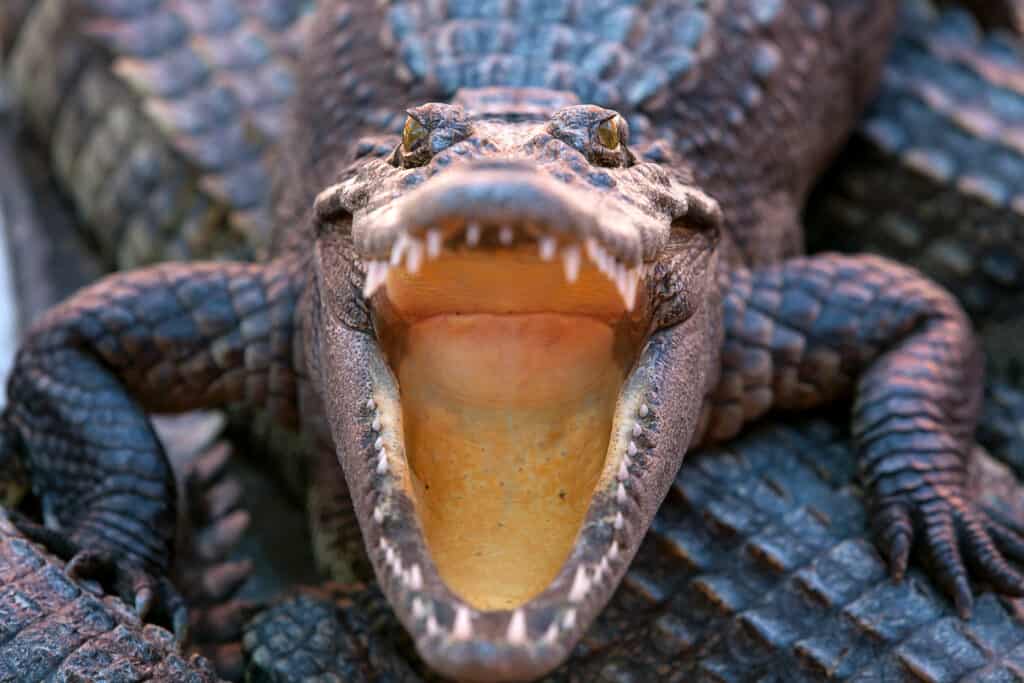
A crocodile in
Africa
is believed to have killed at least 200 people.
©nattanan726/Shutterstock.com
Did you hear about Gustave the Nile crocodile in Burundi? He’s one of the world’s most dangerous crocodiles around. It’s believed that this 60-year-old croc is responsible for over 200 fatal attacks on humans. And the craziest part is that it doesn’t appear like he’s killing to eat. Instead, it’s more for sport. Gustave often kills his victims and then abandons their bodies.
Gustave is one elusive beast and has escaped capture year after year. To this day, he’s still out there in the wild, waiting for his next victim. Since they can’t be certain, scientists have to guess his age, putting this crocodile at around 60 years old. Eyewitnesses guess the crocodile is at least 20 feet long and likely weighs 2,000 pounds. A size that’s unheard of for Nile crocodiles.
Nile crocodiles are native to Africa and prefer rivers and swamps. They usually grow up to 14.5 feet long at the most and top out with a weight of about 900 pounds. But not Gustave, this record-breaking fear-striking croc is nearly the size of two Nile crocodiles.
Lake Tanganyika is where Gustave resides. When he’s not attacking people, he dines on the diverse species in and out of the water, such as mammals and fish. And unlike the American crocodile, Nile crocodiles can reach swimming speeds of 33 mph.
Some Crocodiles Are as Big as Rhinos
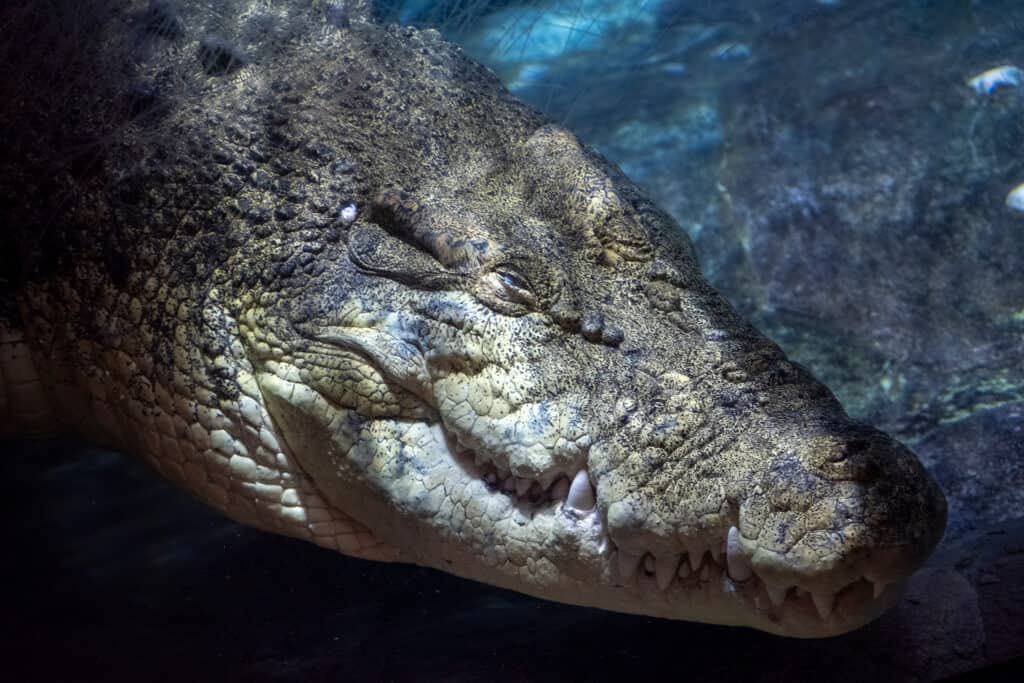
The largest crocodile in the world was 22 feet long and weighed 2,200 pounds.
©Photo Oz/Shutterstock.com
Crocodiles can be as big as rhinos! The largest crocodile in the world was 22 feet long and weighed around 2,200 pounds. The second largest crocodile ever recorded is 20 feet three inches long. These humongous sizes aren’t the norm. Instead, the average size of estuarine crocodiles is between 10 and 16 feet long.
One oversized crocodile has been playfully nicknamed, Dominator, and he’s a big one. Dominator is a 20-foot crocodile living in the Adelaide River in Australia. Supposedly, he’s the second-largest crocodile ever seen.
Crocodiles Never Stop Growing
How do these monster crocs get so big?
Crocodiles don’t die of old age but rather cease living when an external factor or sickness causes death. As long as they’re living, they’ll continue to grow. Considering crocodiles can live up to 70 years or longer in the wild. That’s a lot of time to increase their lizardry length.
The saltwater crocodile grows especially large since it has the longest lifespan. The oldest recorded crocodile was a saltwater crocodile that lived to 140 years old.
A Crocodile Was Living In Paris Sewers

There was a crocodile in 1984 living in the sewers of Paris.
©Khalil Ahmed/Shutterstock.com
Crocodiles in Paris! In 1984, a Nile crocodile was found living in the sewer system near the Seine River in Paris. How did it get there? It was probably a pet that grew too big and was released into the sewers. While it’s sad to think of someone abandoning their pet, the good news is that the Nile crocodile had plenty to eat. The crocodile may have helped control the rat population in the sewers while it was down there.
How often do crocodiles wind up in sewers? A lot more often than you might think! There have been reports of alligators and crocodiles found in sewers in other cities, such as New York City. But it’s hard for large populations to thrive in the sewers; the habitat just isn’t sufficient.
Whatever became of the Paris crocodile after they discovered it? The story does have a happy ending.
After capture, the crocodile was taken to a zoo in Paris. Later she was transferred to an aquarium in Vannes. The famous Paris crocodile, later named Eleanor, lived to be 40 years old. Her story inspired a children’s book titled “Kylie the Crocodile in Paris.”
Crocodiles Swallow Pebbles and Rocks
Crocodiles are big pebble worms!
The word “crocodile” comes from the Ancient Greek word “krokódilos.” The term is a combination of the words “krokè,” which means pebbles, and “drills,” which means worm. This combination may have referred to their worm-like movements when they wiggle through the water. And oddly enough, this name is more appropriate than you might think. These reptiles know a thing or two about eating pebbles.
Crocodiles and alligators have a habit of swallowing stones. But they don’t do this for the flavor. Instead, swallowed stones also act as ballast, weighing them down. This allows crocs to stay still in fast-moving currents while waiting patiently for their next meal.
The stones, called gastroliths, help reduce the buoyancy of crocodiles, which is helpful since their lungs are incredibly buoyant. By becoming heavier, crocs and gators can easily drag their prey underwater or stay submerged, waiting to attack. Another benefit of swallowing stones is that crocodiles are able to hold their breath longer.
The photo featured at the top of this post is © Jesus Cobaleda/Shutterstock.com
Thank you for reading! Have some feedback for us? Contact the AZ Animals editorial team.






